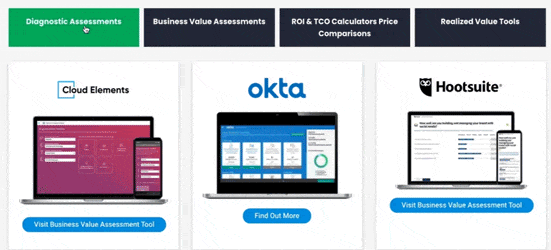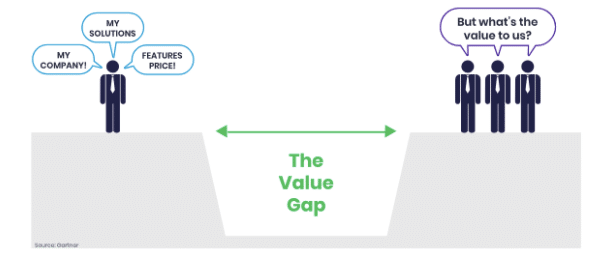As sales interactions become increasingly digital and remote, sellers need to work smarter to capture buyers’ attention and win business. Moving from pitching products to value selling can help.
In this article, we’ll answer:
Why Should I Adopt a Value Selling Approach?
What are the Benefits of Value Selling?
How Do I Create and Execute Challenge-Based Sales Stories?
What Tools Can I Leverage to Support My Value Enablement Efforts?
How Do I Measure the Success of My Value Enablement Programs?
What is Value Selling?
Value selling is a sales methodology that prioritizes quantifying and communicating the value of products and services to customers over product features and capabilities.
Sellers who adopt value selling are more consultative and prescriptive than traditional sellers.
They avoid pitching products, and instead, uncover their buyer’s challenges and speak to how their products or services can help solve those specific problems and benefit the buyer’s business.

In our Sales Leader’s Guide to Value Selling, I liken value selling to convincing my toddlers to eat their vegetables. If I tell them they’re leafy, green, and contain vitamins, I’ll get blank stares. If I tell them spinach is going to make them as strong as the Hulk and as smart as Iron Man, they’ll dig in.
When you explain the value of adopting your product or solution in the context of what’s most important to your buyer, you turn a purchase into an investment. You inspire your buyer to act. And you motivate her to do it quickly.
Why Should I Adopt a Value Selling Approach?
Did you know:
- 38% of purchase cycles end in “No decision”?
- 67% of companies say they underperform at getting executive-level prospects to buy now rather than later?
- 66% of buyers say making a clear ROI case highly influencers their purchase decisions?
- 95% of buyers now require financial justification on any significant purchase?

B2B selling has always been hard. But in today’s business climate, it’s near impossible.
Finance leaders want to cut costs, consolidate vendors, and do more with less. B2B purchase committees with competing business priorities are larger than ever. And Zoom fatigue has made it harder to engage remote buyers.
For all of these reasons, it has become increasingly difficult for B2B buyers to justify and make a business purchase.
To make a confident purchase decision, buyers need to know they’re making worthwhile investments with their time and money. And value selling (also known as ROI selling) is a foolproof way to convince them.
What are the Benefits of Value Selling?
Companies that shift from pitching products to value selling experience:
- Increased buyer engagement and conversion rates
- Less stalled pipeline opportunities
- Higher revenues from new and existing customers
- Faster sales cycles
- Larger average order values
- Increased competitive win rates

How Do I Create and Execute Challenge-Based Sales Stories?
There are two important steps you must take to shift your sales methodology from pitching products to selling value:
Step 1: Change Your Sales Story
Your buyers have a lot of choices. Your sellers have to communicate how your solution is unique.
Unfortunately, when many organizations attempt to articulate the differentiating value of their offering, they use a product-first approach, rather than a business challenge-first approach.
The result is a Value Gap, a divide between buyer expectations and a traditional sales and marketing approach.
The Value Gap can critically impact revenue growth with more stalled deals, longer sales cycles, and increased discounting. A simple conversation guide can help you combat this.

The CLOSE Conversation Guide
CLOSE is a storytelling framework with five key sequential elements that help you formulate your value proposition with maximum impact:
Challenge, Loss, Opportunity, Solution, Evidence
The framework combines the right balance of emotion, rationale, and evidence to help your sellers develop the necessary conversation elements and effectively articulate your value story in a way that resonates with buyers.
Here’s what that looks like:
Challenge – What challenge can you help your prospect tackle?
This can be a challenge that the buyer may or may not already realize they have. Use compelling commercial insights to help them understand the implications of the challenge. You can also use customer use cases to help communicate how the challenge typically manifests.
Loss – What is the challenge currently costing them?
Next, you’ll want to quantify the specific cost of “doing nothing.” What happens if the buyer chooses not to solve the problem? Numbers are great. Think unnecessary expenses, lost productivity, lost revenue, etc.
Opportunity – What is the value of addressing the challenge?
Communicate the potential business benefits of solving the challenge. Tie the impact back to their specific value drivers such as cost savings, reduced risk, or revenue growth.
Solution – What solution can deliver these business benefits?
Now that you’ve talked about their challenge, you can talk about how your product will solve it. Communicate the specific solutions that can be used to address your buyer’s problem and document the proposed business benefits.
Evidence – How do you prove the proposed solution can deliver?
Don’t forget to validate how the proposed solution has helped similar customers overcome the challenge. Quantify specific customer benefits such as ROI, KPIs, etc.
Step 2: Align Your Sales and Marketing Content
The buyer journey isn’t linear, and today, much of it is self-guided and digital.
To make sure your prospects and customers hear consistent value messaging throughout their entire journey, always create sales content that discusses your buyer, the challenges they face, and what inaction costs them each day.
This impactful messaging, insights, and justification gives buyers what they need to convince key stakeholders to buy in, enables sellers to engage earlier and successfully speak to the unique value of your product or service in the context of what matters to the buyer, and fuels provocative and engaging sales conversations.
What Tools Can I Leverage to Enable My Organization to Value Sell?
Sales Enablement Software
Sales enablement software can help you ensure your sellers and marketers are communicating your value proposition at the right time and in the right way throughout the buyer journey.
Deploying an AI-powered sales enablement platform that incorporates content management, guided selling, and interactive presentation capabilities enables your sellers and marketers to:
- Manage, distribute, and search all up-to-date sales and marketing content in one place
- Access, present, and share relevant sales content on-demand
- Understand how buyers are consuming individual content assets and whether or not they’re engaged
- Pivot sales conversations to address what’s most important to the buyer in real-time
- Create tailored buying experiences with content that is relevant, accurate, and on-brand
- Optimize existing content based on real data and insights
- Lead more engaging sales conversations with interactive and dynamic content that holds your buyer’s attention
Business Value Calculators
Many companies turn to spreadsheets to help sellers quantify and communicate return on investment (ROI) or total cost of ownership (TCO) for buyers. But this isn’t the most effective or sustainable way to support your value selling efforts.
Spreadsheets are problematic for a number of reasons including high development costs, limited version control, and low adoption rates. (We dig deeper into why value spreadsheets are a bad idea in our guide Why Spreadsheets Don’t Work.)
Fortunately, sales tools can deliver where spreadsheets fail. Leveraged by both sellers and marketers, various types of interactive value selling tools can help buyers answer important questions along the increasingly complex buyer journey. Here are some examples:

Custom Diagnostic Assessments – Deployed as self-service tools on your website, custom diagnostic assessments help buyers answer “why change?”
These tools illuminate customer pain points and pique interest in how your product or service can solve a specific problem. The assessments drive lead generation and present an opportunity for sales reps to engage earlier in the buying process.
Business Value Tools – Leveraged by sellers throughout the exploration and evaluation stages of the buyer journey, business value tools help prospects answer “why now?”
ROI calculators help sellers quantify what the buyer will gain from the purchase of a product or service and make it easier for buyers to take proposals up the chain for stakeholder approval.
TCO Tools – TCO tools help sellers answer “why you?” by providing a visual cost-benefit analysis of your product or service side-by-side with your competitors.
Realized Value Calculators – Used post-sale, realized value calculators help buyers answer “why renew?”
These calculators uncover proof points and projections to show value in the purchase of more licenses or additional solution sets to create upsell and cross sell opportunities.
All of these value selling tools help accelerate deal cycles and improve win rates. They also empower sales management to onboard and train sellers faster and ensure the entire sales team can communicate your value proposition in a consistent, engaging, and accurate way.
How Do I Measure the Success of My Value Enablement Programs?
Before launching interactive value selling tools, it’s important to identify how you’ll gauge your success so you can continue to optimize and benefit from your value enablement programs. We recommend tracking metrics in three categories: Usage, Scale, and Move the Needle.

Key Takeaways

- Today’s buyers need financial justification to get budget approval for projects.
- Most sellers are still pitching products, but sellers that leverage value selling close more deals faster.
- You can shift from pitching products to value selling by using the CLOSE framework in sales conversations and sales content: Challenge, Loss, Opportunity, Solution, Evidence.
- Sales enablement software can help you ensure consistent value messaging is communicated throughout the entire buyer journey.
- Value Selling tools are easier to scale than spreadsheets, resulting in faster sales onboarding.
- Different types of value assessments and calculators can be leveraged at different stages of the buyer journey to effectively quantify your unique value proposition in a way that resonates with buyers.
- Don’t forget to track and measure the success of your value programs!
Just getting started with Value Selling? Download Storytelling 101: A Guide for Modern B2B Sellers to begin transforming your sales stories today.

Comments are closed.